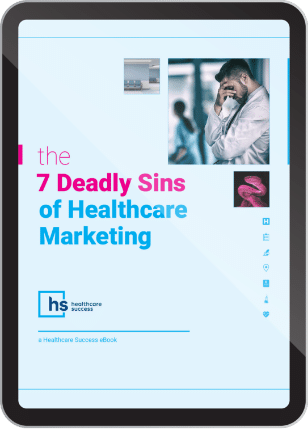What Makes for a Marketing-Based Website?
 Today, any successful hospital or practice should maintain a website so patients can find your location and learn a little bit about your services. You might think that a great looking site is just a bonus...but from a website marketing perspective, this is far from the truth.
Today, any successful hospital or practice should maintain a website so patients can find your location and learn a little bit about your services. You might think that a great looking site is just a bonus...but from a website marketing perspective, this is far from the truth.
You cannot expect to simply put up a website and see patients line up at your door. Ongoing marketing is a key part of running any hospital or practice in today’s world, and that is highly dependent on your website. Although a beautiful web design is certainly part of that, a successful strategy needs much more.
Contact Information on Every Page
This may seem simple enough, but it’s too often overlooked. A hospital or practice’s address, contact number, hours, and email address should be located on every page of the website in an easy-to-find location.
Ideally, there should be a contact form on the site that prospective patients can easily fill out to get information or request an appointment. This form may be linked at the top of the page or embedded into the design of each page.
Responsive Website Marketing Design
Responsive design is the norm in website marketing today, but a busy practice may not realize their site is currently out-of-date. Having a responsive site means it will appear the same whether viewed on desktop, mobile, or tablet. Google actually indexes responsive sites higher than non-responsive (outdated) ones, so if you haven't made an update, your website can actually be hurting you.
User-Friendliness
When you examine your copy and design from a website marketing point-of-view, you have to think of what patients look for and how easy the information is to find. Some questions to consider…
- Would a patient know what services you offer within 10 seconds of viewing your home page?
- Is your contact information located near the top of the page?
- Is your navigation bar at the top easy to understand and click through?
- Is the site accessible to people with disabilities?
- Could a slow site speed stop someone from staying on your site?
User experience is something marketers always keep in mind. A sleek design is only part of the equation--it must be simple to navigate as well.
High-Quality, Relevant, Personalized Imagery
People can tell when you've used low-quality stock images instead of creating a custom look. They can also tell when an inexperienced photographer uses a cell phone to post images without any editing. High-quality imagery is important for any website, and it should be as relevant as possible to your hospital or practice's services.
You should also attempt to target your typical or ideal patient. Finding imagery that represents the typical patient in age, appearance, or gender is especially important in healthcare website marketing, where patients want to know that a hospital or practice is inclusive.
See also: The State of Multicultural Marketing in 2018
Jargon-Free Copy
People often have a tendency to write to their own comprehension level rather than what the average reader is expecting. The markings of copy that’s easy to read include…
- Short, simple sentences written in the active voice
- Short paragraphs with clear headers for each section
- Bullet points to make it easier to digest lists of services, common questions, etc.
- Phrasing centered around the patient’s needs in the second person, meaning the word "you" should be used frequently
- Vocabulary that nearly ANYONE could understand
If you’re going to use technical, academic, or medical terms, it must be for a reason and it should be defined. Patients don’t want to know whether you do endondics; they want to know if you’re a dentist. They don’t want to know that you offer obstretrical care; they want to know if you are an OB-GYN.
Think about terms patients use when they speak with you. If there are any unfamiliar terms in your copy, define them (on every page where they are used).
Search Engine Optimization
Optimizing for search engines means more than just including keywords in your copy. This is certainly important: it helps the search engines know what services you offer so they can properly index your site. However, there are many other things the search engines look for, such as business location information, meta tags, backlinks from other sites, and more.
Appropriate Calls to Action
What do you want a prospective patient to do when they land on your webpage? Do you want them to fill out a contact form? Schedule an appointment by calling your number? Schedule a free consultation?
The call-to-action should clearly state what action you want someone to take. And this doesn’t just mean within the text. Large buttons near the top of the page that link to a contact form or phone number work best in terms of user experience.
Testimonials
In this day and age, it’s easy for people to gather information about a hospital or practice online. Wouldn’t you rather they get accurate testimonials from your own website?
The problem with third-party websites is that you have no way to manage them except to respond. When you use an internal reputation management system, a rating system helps you to determine which patients are good candidates to leave a review on your website and which patients can give you feedback to help you improve. With this process, top ratings are featured on your website, and your hospital or practice is able to make improvements based on patient feedback.
See also: 9 Essential Steps to Improve Doctor Ratings Online








